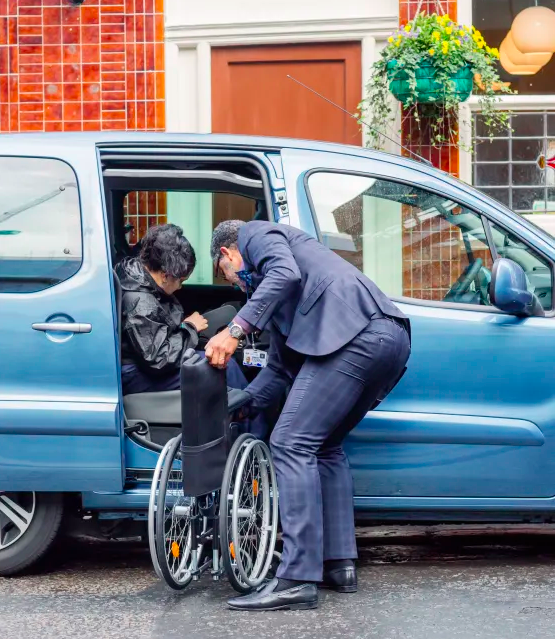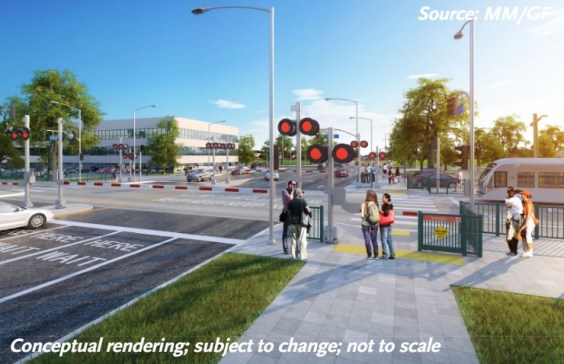California Seeks to Improve Wheelchair Service on Uber, Lyft
4:33 PM PST on December 20, 2021

Image: Uber
The state of California recently took a big step toward improving the experience of ride-hail customers who use wheelchairs or medical scooters.
While public transit agencies are required to make their vehicles wheelchair accessible and also provide paratransit shuttle service for people who cannot take a bus or train, ride-hail services such as Uber and Lyft have been working under different rules. A recent California Public Utilities Commission (CPUC) decision [PDF] will change those rules to encourage ride-hail companies to increase the number of wheelchair-accessible rides they provide.
This decision will in many ways benefit riders who rely on wheelchairs, although some advocates say it does not go far enough because the new regulation will not mean service levels are equivalent to non-wheelchair-accessible service, and people with wheelchairs will still face longer wait times.
Currently, the state requires companies to levy a ten cent fee on every ride-hail trip, and the money goes into a fund called Access for All. Ride-hail companies can request to keep some of these fees, rather than give the money to the CPUC, but they must show that they are using the funds to offset the costs of improving wheelchair-accessible service. These offsets can be upwards of millions of dollars; for example, Uber applied to keep about $843,000 in 2020, which was a very lean year for ride-hail.
The recent decision includes new, stricter benchmarks for ride-hail companies to qualify for an offset. In addition, the trips must be completed to count towards this requirement. This addresses the fact that some disabled riders have historically faced higher rates of driver no-show, or cancellation, despite company policies that strongly discourage cancellations.
These new benchmarks also vary by county, acknowledging the differences in the availability of wheelchair accessible vehicles in urban, suburban, and rural counties. In addition, they require that wait time between a ride request and arrival of the vehicle be kept shorter than a specified maximum for riders who use wheelchairs, in recognition that longer wait times for riders in wheelchairs can result in inequitable service. Wait times directly correlate with the number of vehicles in a ride-hail fleet. Longer wait times reflect the fact that there are fewer wheelchair accessible vehicles in service, meaning when a rider requests a ride, the only available driver is likely to be farther away.
These new regulations advance an ongoing discussion by state regulators on this topic. In April 2021, we wrote about a regulatory decision made in March 2021 [PDF]. At that time, California state regulators said that if a ride-hailing company wanted to keep some of its Access for All fees, it would have to show either a larger absolute number or a larger percentage of completed wheelchair- or medical scooter-accessible trips within a given area from one fiscal quarter to the next.
We pointed out that there was a flaw in this method: there was a chance that even if a ride-hailing company completed a larger absolute number of such trips, the percentage of them could still decrease. A company could qualify for an offset simply by showing one more completed wheelchair-accessible trip than in the previous quarter. Disability advocacy groups, including the Disability Rights Education & Defense Fund, and public transit agencies had called instead for standards to be based on percentages that increase over time.
This new decision reflects this feedback and applies a much more nuanced percentage-based system. In particular, the CPUC has mandated that a ride-hailing company in a given county is eligible to keep some or all of its Access for All fees only if it completes at least half of its requested trips, and this minimum threshold will increase gradually over time.
The thresholds also vary by county. All of California’s counties are categorized based on the number of ride-hail vehicles available (which loosely corresponds to whether a county is urban, suburban, or rural) and each is assessed to identify feasible levels of improvement based on the availability of local ride-hail service. For example, companies working in a densely populated area like San Francisco County would have to complete the minimum of half of all wheelchair- or medical scooter-accessible trips, working eventually up to completing at least 75 percent of them. Other counties that include a mix of urban and suburban areas would work towards a final threshold of seventy percent, and mostly rural counties would be required to eventually complete sixty percent of such requested trips.
Similar county-level thresholds will also apply to wait-times, and the new requirements will require ride-hail companies to shorten wait times over time.
Open Questions
There are several other issues that remain open questions for state regulators to address. These include whether any companies will be exempt from the requirements. So far, the CPUC has taken a “no exceptions” approach, requiring all companies large and small to abide by these regulations. These include shuttle providers, smaller ride-hail companies, and automated vehicles. Taxi companies are also not included, because unlike ride-hail, taxis have their own legal requirements for accessibility, the result of years of work. Absent state legislation, taxis cannot participate in the ride-hail program, nor can they collect or keep any Access for All Funds.
There is a gray area for some shuttle - or microtransit - providers, when they contract with public transit agencies to provide demand-responsive services. Those contracts require them to follow the same disability access rules as the agencies. Public transit agencies must comply with Title II of the Americans with Disabilities Act (ADA), which has a number of requirements. For example, all buses must be wheelchair-accessible, alternative options such as paratransit shuttles must be available and wheelchair-accessible, and paratransit must be available to those who do not have usable sidewalk paths to buses. Importantly, there are no wait-time requirements for paratransit shuttles, and many have terrible thirty- to sixty- minute pick up windows, and riders usually have to book a ride 24 hours in advance.
However, microtransit shuttle providers are attempting to improve this situation. They are aiming to provide higher quality service options to allow transit agencies to provide on-demand service more efficiently. While these services should certainly help improve wait-times and ensure there are very few cancellations, the benchmarks for success might look different. While some of these microtransit companies are classified as ride-hail companies, they typically have relatively small fleets of vehicles. When they’re paid for by transit agencies, they’re especially small - and as we mentioned earlier, wait times and fleet size are directly correlated. The CPUC has not decided whether these shuttle services must follow the new ride-hailing regulations or whether they are exempt because they are already subject to the ADA Title II regulations. It would be unfortunate if this CPUC action hurt the ability for transit agencies to partner with microtransit providers.
The CPUC also decided not to exempt smaller ride-hailing companies from its rules nor modify the rules for such companies. However, given that state regulators are tackling this issue bit by bit, they may rule in the future on exemption criteria for these companies.
They could also address whether future automated vehicles operating as ride-hail companies must comply. Much like shuttle companies, while some automated vehicles may be classified as ride-hailing vehicles, their business models might be somewhat different. There may need to be some more nuanced categorizations of businesses to account for future variety in the industry.
Relevant Legal Battles
There are also ongoing court cases relevant to determining what accessibility outcomes are the responsibility of ride-hailing companies. Plaintiffs in a 2020 District Court case in California, Independent Living Center San Francisco et. al. vs. Lyft Inc., argued that longer wait times and lack of late-night service is discriminatory under ADA Title III. The judge ruled that Lyft should “make reasonable modifications to rectify a discriminatory policy, practice, or procedure.” However, at the same time the plaintiff’s ideas for “accommodations” - which included extra marketing investments, wheelchair accessible vehicle rentals to drivers, and partnerships with transit agencies - were denied. The judge ruled that plaintiffs failed to show that any of these would be effective strategies alone, and together they would be so costly that they would be considered unreasonable. This “reasonableness test” is partly why taxis have never been required to provide ADA compliant rides, and why Amtrak and Greyhound have faced legal issues and still have noncompliant vehicles and facilities.
Another example is a legal complaint filed by the U.S. Department of Justice against Uber, alleging that the company unfairly charges many riders with disabilities for longer boarding and disembarking times even though those riders inherently need more time to get in and out of vehicles. It remains to be seen whether such issues will be resolved through court cases or whether the CPUC, recognizing the relationship between boarding/disembarking times and equity, will create new rules to ensure that riders with disabilities are not financially penalized for their disabilities.
Concluding Thoughts
The CPUC acknowledges that the COVID-19 pandemic has changed travel patterns a lot, and the pandemic is not going away anytime soon. The agency has called for more study of response times for wheelchair- and medical-scooter accessible ride-hail requests over the next year or so - until February 2023 - to see how the last fifteen months of ride-hail use has been affected by this pandemic.
More study would make clear the effects of the pandemic on the travel of riders who need wheelchair access. The proposed wait time benchmarks aren’t yet the same as the wait times promised for most riders who don’t need wheelchair access, and additional study would help clarify how to bring them closer to being fully equal. Meanwhile the recent CPUC decision should help provide riders who need wheelchair access more predictable wait times, and it sets the groundwork for stronger standards in the next few years.
Overall, we applaud the CPUC for taking on these challenging issues and for responding with noticeably improved standards.
Prashanth Venkataram is a postdoctoral researchers at the UC Davis Institute of Transportation Studies and Mollie D’Agostino is the Policy Director of UC Davis’ 3 Revolutions Future Mobility Program.
Streetsblog California editor Melanie Curry has been thinking about transportation, and how to improve conditions for bicyclists, ever since commuting to school by bike long before bike lanes were a thing. She was Managing Editor at the East Bay Express, editor of Access Magazine for the University of California Transportation Center, and earned her Masters in City Planning from UC Berkeley.
Stay in touch
Sign up for our free newsletter
More from Streetsblog California
California Leaders Celebrate Ten Years of Climate Action
Air Resources Board report highlights progress funded by the California Cap-and-Trade Program
How Car-Centric Cities Make Caring For Families Stressful — Particularly For Women
Women do a disproportionate share of the care-related travel their households rely on — and car-focused planning isn't making matters easier.
A Very Ferry Future. Plus Advocates Call BS on ‘Welcoming West Portal Committee’
A whole lot more ferry service proposed for the Bay Area
Wednesday’s Headlines
Cash incentives can change transportation habits; Safer streets need investment; Suburbs don't want to support public transit; Depaving; More
San Fernando Valley Bus/Bike Updates: G Line, Roscoe Bus Lanes, Laurel Canyon Bike Lanes
Short newly protected bike lane on Laurel Canyon Blvd, extensive NSFV bus improvements under construction this month, and scaled-back G Line plans should get that project under construction this summer




